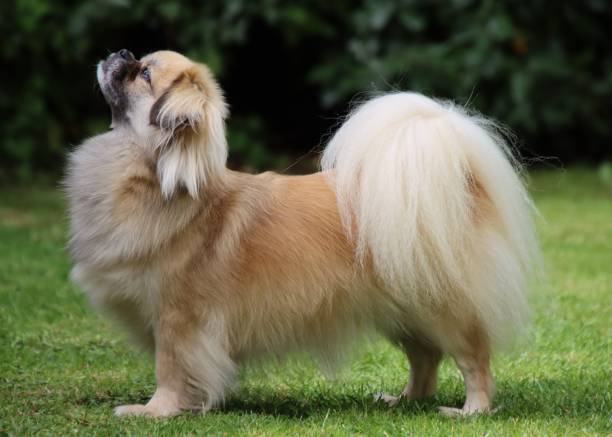Tibetan Spaniel

Breed History:
The Tibetan Spaniel is an ancient breed believed to have originated over 2,000 years ago in the Himalayan mountains of Tibet. Despite the name, it is not a true spaniel but rather a companion dog bred and treasured by Buddhist monks.
Tibetan Spaniels lived in monasteries, often acting as lookout dogs on the walls, alerting the monks of approaching strangers. They were also cherished for their warmth, often sleeping beside monks to provide physical comfort. The breed remained largely isolated until the late 19th and early 20th centuries, when it was introduced to the West.
Height: 23-27 cm
Weight: 4-7 kg
Size – Small
Life Expectancy: 12–15 years

Breed Appearance:
The Tibetan Spaniel is a small, well-balanced dog with a slightly longer body than height. It has a silky, medium-length double coat, a plumed tail that curls over its back, and a distinctively expressive face with a short muzzle and dark, oval eyes.
Its mane-like neck fur gives it a lion-like appearance, reminiscent of the lion dogs seen in Tibetan art. Coat colours vary widely and include gold, cream, red, black, white, and sable, often with a mixture of shades.
Breed Type – Companion/Watchdog:
Although small, the Tibetan Spaniel is alert, independent, and surprisingly bold. It was bred primarily as a watchdog and companion, making it deeply devoted to its family. It tends to be aloof with strangers but affectionate and loyal to its people.
This breed is known for its cat-like behaviour—it enjoys high perches, watches the world with curiosity, and is quite agile. It makes an excellent companion for those seeking a small but confident watchdog.

Training:
Tibetan Spaniels are intelligent and independent, which can make training a bit of a challenge for first-time dog owners. They are capable learners but prefer to do things on their terms.
Training should be positive, consistent, and patient, using rewards rather than force. Early socialisation is key to managing their natural wariness toward strangers. Despite their stubborn streak, they are very in tune with their owners and often eager to please.
Health & Care:
Generally, a healthy and hardy breed, Tibetan Spaniels benefit from regular veterinary care and screenings. Known health issues include:
-
Progressive retinal atrophy (PRA)
-
Patellar luxation
-
Portosystemic shunt (liver shunt)
-
Respiratory issues in extremely hot or humid weather are due to their short muzzle
Maintaining a balanced diet, routine checkups, and dental hygiene will help ensure a long, healthy life.

Living Conditions:
The Tibetan Spaniel is well-suited to apartment living and urban settings, provided it receives enough exercise and interaction. Its moderate energy level makes it adaptable, but it should not be left alone for long periods, as it forms strong bonds with its people.
It prefers moderate climates and does well in indoor environments. A home with access to windows, perches, or balconies will satisfy its love for surveying its surroundings.
Exercise:
While not a high-energy breed, the Tibetan Spaniel needs daily walks, playtime, and mental stimulation to stay happy and healthy. 30–45 minutes of activity per day is typically sufficient.
It enjoys games, puzzle toys, and especially exploring elevated places like furniture or window ledges. It's agile and enjoys activities like short agility runs or low-impact games, but it does not require rigorous exercise.
Grooming:
The Tibetan Spaniel has a low-maintenance coat that requires brushing once or twice a week to remove loose hair and prevent tangles, especially around the ears and neck.
It is a seasonal shedder, with heavier shedding in spring and fall. Bathing is needed only occasionally. Regular ear cleaning, nail trimming, and dental care are important parts of routine maintenance.

Advantages:
-
Loyal, affectionate, and forms deep family bonds
-
Cat-like agility and cleanliness
-
Good watchdog with keen senses
-
Requires only moderate grooming and exercise
-
Small size is ideal for apartments and urban living
-
Long lifespan and generally healthy
Disadvantages:
-
Can be aloof or reserved with strangers
-
Stubborn and independent-minded—may resist training
-
Prone to separation anxiety if left alone too long
-
Needs socialisation to avoid excessive barking
-
May develop small-dog syndrome if not properly trained
-
Sensitive to heat due to short muzzle

